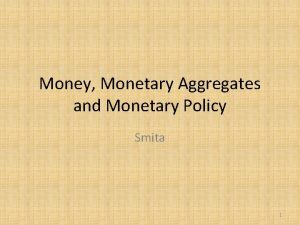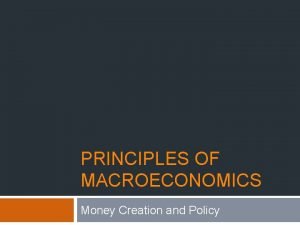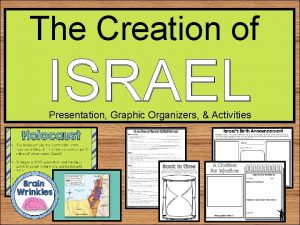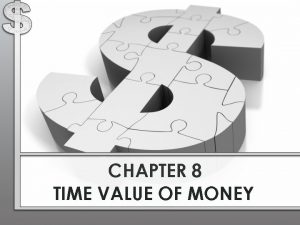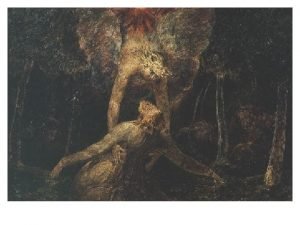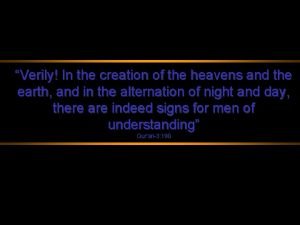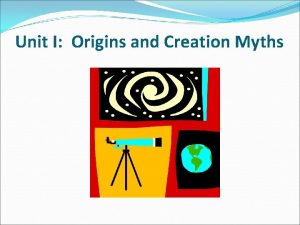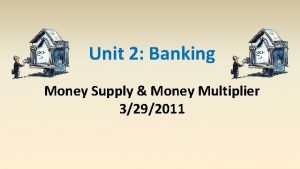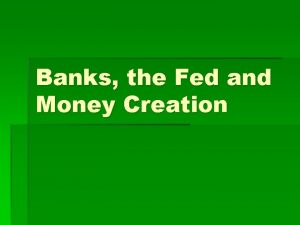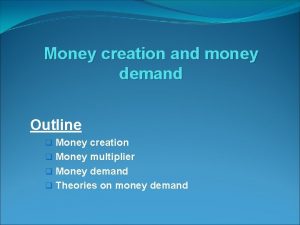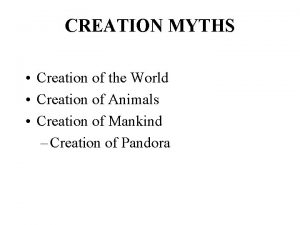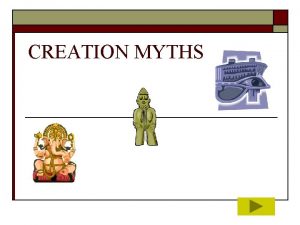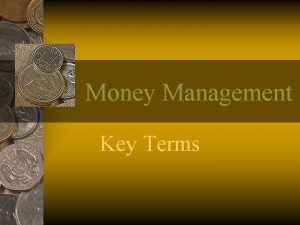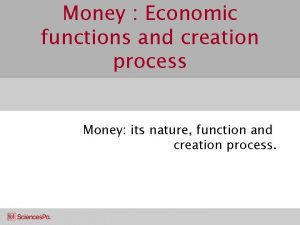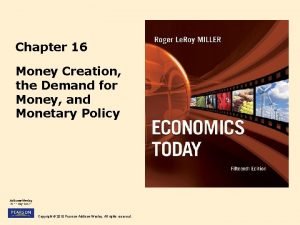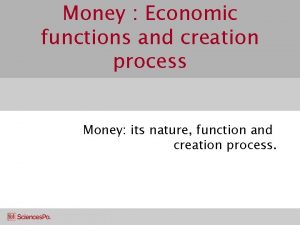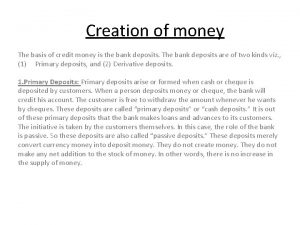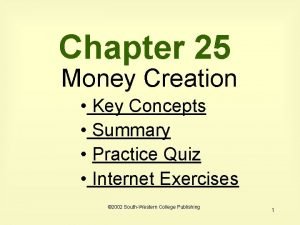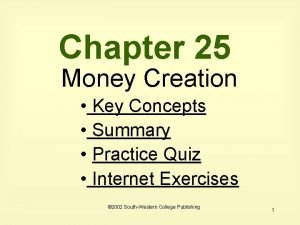Money Creation Key Topics How is money created


















- Slides: 18

Money Creation

Key Topics • How is money created in the economy? • The major tools the Federal Reserve uses to control the money supply? • Reserves • Discount Rate • Open Market Operations • The federal funds rate?

History In the Middle Ages, gold was the money of choice in most European nations Goldsmiths, people who would keep other people’s gold safe for a service charge founded the modern banking People used receipts from a goldsmith as paper money (the first currency) Goldsmiths made loans and received interest (first banks) Today banks get their money to lend from depositors

Modern Banking Fractional reserve banking is a system in which banks keep only a small percentage of their deposits in reserve Required Reserves The minimum balance that the Fed requires a bank to hold in vault cash or on deposit with the Fed Required Reserve Ratio The percentage of deposits that the Fed requires a bank to hold in vault cash or on deposit with the Fed

Required Reserve Ratio of the Fed Checkable deposits 0 - $46. 5 million 3% Required Reserve Ratio Over $46. 5 million 10% Required Reserve Ratio Excess Reserves Potential loan balances held in vault cash or on deposit with the Fed in excess of required reserves Banks are allowed to loan money taken from their excess reserves Total Reserves equal required reserves plus excess reserves

Steps in the multiplication of money • accepting a new deposit • making a loan • clearing the loan check

Bank - Balance Sheet Bank – One (1) Assets Liabilities Required Reserves Excess Reserves $10, 000 $90, 000 Original Deposit $100, 000 Total $100, 000 Bank – One (2) Assets Required Reserves Excess Reserves Loan Total Liabilities $10, 000 $0 $90, 000 $100, 000 New Deposit $100, 000 Total $100, 000

Bank - Balance Sheet Bank – Two (1) Assets Liabilities Required Reserves Excess Reserves $9, 000 $81, 000 Original Deposit $90, 000 Total $90, 000 Bank – Two (2) Assets Required Reserves Excess Reserves Loan Total Liabilities $9, 000 $0 $81, 000 $90, 000 New Deposit $90, 000 Total $90, 000

Money Supply Expansion Required Reserves Excess Reserves Bank Two Bank Three Bank Four Bank Five Bank Six Bank Seven All banks $100, 000 $90, 000 $81, 000 $72, 900 $65, 610 $59, 049 $53, 144 $478, 297 $10, 000 $9, 000 $8, 100 $7, 290 $6, 561 $5, 905 $5, 314 $47, 830 $90, 000 $81, 000 $72, 900 $65, 610 $59, 049 $53, 144 $47, 830 $430, 467 Total increase $1, 000 $100, 000 $900, 000 Banks Bank One Deposits

Money Supply The money supply increases when banks lend money to borrowers Money Multiplier: As money is passed from person to person, there is a multiple effect on any initial money banks lend to borrowers Money Multiplier = 1 required reserve ratio 1 0. 20 1 0. 05 = 1 0. 10 =5 = 20 There is an inverse relationship between the size of the required reserve ratio and the money multiplier

Money Supply Change in the Money Supply M 1 = ER x m $100, 000 = $10, 000 x 10 Initial change in excess reserves Money multiplier

Money Supply The multiplier can be smaller than indicated because of cash leakages and the chance that banks will not use all of their excess reserves to make loans A leakage example: Some people receive money then decide to save the entire amount instead of spending most of it The Fed decreases the money supply during inflationary periods The Fed increases the money supply during periods of unemployment. The Fed use its monetary tools to influence the liquidity of banks

Money Supply – Liquidity measures of the ease with which an asset can be converted into money without a significant loss in value Banks are liquid when they have ample excess reserves Banks will do everything possible to lend out these excess reserves Banks are less liquid when they have less excess reserves They cannot lend out very much money Feds Money Policy During an inflation period the Fed will take action to make banks less liquid During period of unemployment the Fed will take action to make banks more liquid

The Fed influences a bank liquidity • open market operations • change in the discount rate • change in the required reserve ratio Open Market Operations: The buying and selling of government securities During inflation: the Fed sells securities, this will make banks less liquid and lowers Money Supply During unemployment: the Fed buys securities, this will make banks more liquid and increases Money Supply

Federal Reserve System - Balance Sheet Assets Liabilities Government securities $2, 461 Fed notes Mortgage Backed Sec. $1, 761 Other assets $268 Total $4, 490 Deposits Other liabilities and net worth Total $1, 385 $2, 426 $679 $4, 490 If the Fed conducted open market operations in order to increase the money supply by purchasing $1, 000, 000 in government securities. Assets Liabilities Government securities $2, 561 Fed notes Mortgage Backed Sec. $1, 761 Other assets $268 Total $4, 490 Deposits Other liabilities and net worth Total $1, 385 $2, 526 $679 $4, 490

Discount Rate The discount rate is interest rate the Fed charges on loans to banks During inflation the Fed increases the discount rate During unemployment the Fed decreases the discount rate Federal Funds Market: A market in which banks lend to each other for less than 24 hours Federal Funds Rate: The interest rate banks charge for overnight loans to other banks During inflation the Fed would increase the federal funds rate to restrict bank liquidity During unemployment the Fed would decrease the federal funds rate to create bank liquidity

Reserve Ratio The Fed determines how much a financial institution must keep in reserve as a percentage of its total assets During inflation the Fed would increase the reserve ratio allowing more excess reserves thus increasing liquidity During unemployment the Fed would decrease the reserve ratio reducing excess reserves thus restricting liquidity Not considered a viable monetary tool because changing the reserve ratio generates some instability and is thus infrequently used

Shortcomings of monetary policy • • multiplier inaccuracy competition of non-banks definition of money lag effects
 Money money money team
Money money money team Liquidity adjustment facility
Liquidity adjustment facility Creation of money
Creation of money The creation of israel cloze notes answer key
The creation of israel cloze notes answer key Latin america's geography cloze notes 1
Latin america's geography cloze notes 1 Key partners business model
Key partners business model Business model canvas tripadvisor
Business model canvas tripadvisor Key topics
Key topics Tom buchanan symbol
Tom buchanan symbol Money smart money match
Money smart money match Money on money multiple
Money on money multiple Great gatsby historical context
Great gatsby historical context The great gatsby historical context
The great gatsby historical context Chapter 8 time value of money answer key
Chapter 8 time value of money answer key Elohim creating adam william blake
Elohim creating adam william blake Gradated rhythm
Gradated rhythm Verily in the creation of the heavens and earth
Verily in the creation of the heavens and earth Creation myth definition
Creation myth definition Required reserve ratio
Required reserve ratio

